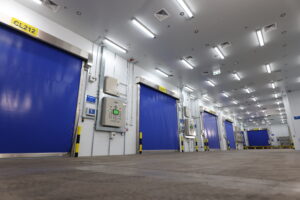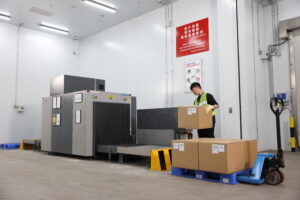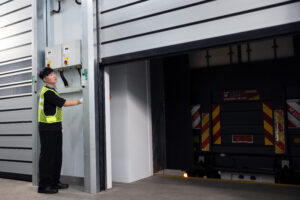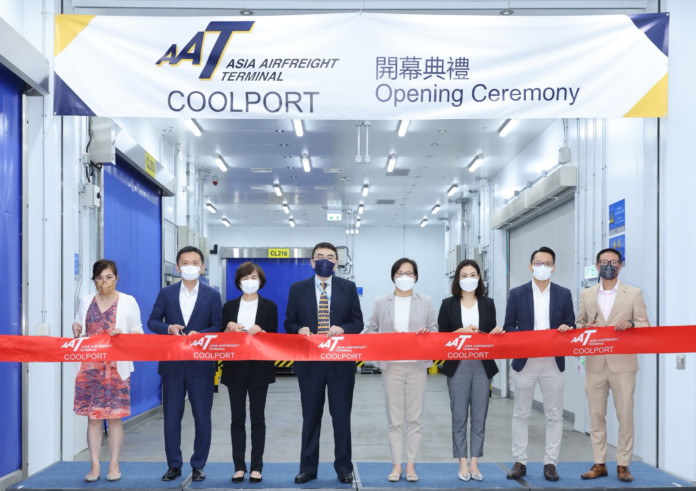

While the air cargo industry prides itself on speed, sometimes there is an interval between the production, distribution or delivery of goods, meaning companies need to turn to cargo facilities to protect their items. This is even more true for perishables or items that require specific temperature-controlled environments to keep them fresh.
Asia Airfreight Terminal (AAT) has long been prepared for handling specialist cargo, with a wide variety of facilities, including a perishable centre, strong room, dangerous goods and radioactive room, storage for live animals and a direct-to-airside facility to accept large animals and last-minute built-up units. Earlier this year it further enhanced its offering, adding the AAT COOLPORT – Hong Kong’s first on-airport temperature-controlled facility built to ensure cold chain integrity for perishable and pharmaceutical airfreight.
Planning for the COOLPORT started before the pandemic, with AAT looking at their existing facilities and exploring what market segments they wanted to really grow and target. “Perishables and pharmaceuticals were always the top priorities in our strategic planning,” Kuah Boon Kiam, CEO of AAT, said. ‘Instead of just upgrading existing sites, AAT decided to build something new that wasn’t available anywhere in Hong Kong airport. “The timing turned out to be quite good because of the fact that, more than ever now, there is a focus on pharmaceuticals and vaccines.”
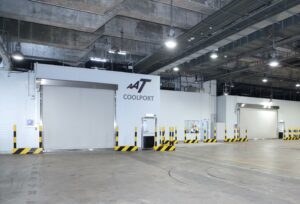

Unique
The COOLPORT stands out in the cargo space, not just because it’s a Hong Kong first but because it continues to represent AAT’s ongoing commitment to offer unique solutions to the growing demand for safe transportation of time and temperature-sensitive air cargo. In a strategic location at the airport, the facility allows for the seamless movement of cargo through the facility in a speedy and effective manner that prevent potential disruptions to the cold chain.
“From the moment cargo is accepted at the air-conditioned truck docks, we have special dock shelters that allow the cargo to come right off the truck into a temperature-controlled environment. There is no exposure to outside temperatures and once it comes into our facilities, it can be weighed, x-rayed, worked on under a specific temperature-controlled environment. That is the key differentiating factor between us and other CTOs. We are the only ones that can keep the cargo in this environment from start to finish.”
Enhancing Hong Kong’s status
HKIA already has the illustrious title of being the world’s busiest airport, having unseated the previous hub after 10 years at the top. The COOLPORT’s launch is only likely to further bolster Hong Kong’s status on the global stage. Increasing AAT’s handling capacity for sensitive cargo by 50%, the COOLPORT shows the region is the world’s hub for perishables and pharmaceuticals.
For Hong Kong specifically, it is hugely beneficial to have added capacity, not just for status but to meet the needs of its own citizens. While some regions are able to sustain themselves without outside support, Hong Kong doesn’t grow its own food and so it relies on importing perishables to feed its citizens. “At any point in time, you could find lobsters from Australia, meat from New Zealand and products from Africa in our hub awaiting delivery.”
The pandemic only increased the demand for the transportation of perishables, as countries diversified where they source their food, raising the number of imports coming in. Similarly, the movement of pharmaceutical goods increased with the need to ship vaccines and medical equipment during that time. “High value pharmaceuticals are needed in a place like Hong Kong. Insulin, fertility drugs, these are high value commodities. Demand is growing, so we are very happy that we made this investment.”
Keeping an eye on the supply chain
For any company moving goods in the current climate, monitoring their progress is now a key requirement, as they seek to reassure customers where their items are and that they are travelling without disruption. This is even more important in the cold chain, where monitoring has to go beyond simply the location and include real time information on the temperature and treatment of the goods.
“Every storage facility has a monitoring dashboard outside where it keeps track of its temperature and humidity. It’s not just in terms of numbers, it is colour coded.” The high tech monitoring data provided has sparked significant interest from airlines, who’ve looked at the facilities and been impressed by the technology on offer. “We can say that if your cargo is handled by us, we can ensure that it is kept within the needed temperature range until you are ready to collect it or until the plane is ready to be loaded. From that perspective, there is a general peace of mind.”
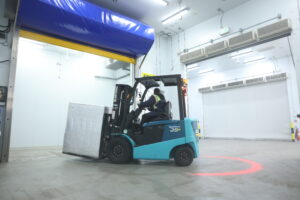

Read more: Asia Airfreight Terminal launches AAT COOLPORT
Feedback is crucial
The air cargo sector is a customer-focused industry, where listening and learning form a crucial part of any business, as it seeks to adapt to meet the needs of potential clients and get ahead of the curve. The market feedback for AAT’s COOLPORT has been “extremely positive” so far, with the hub inviting airlines, agents and shippers to offer their thoughts on the facilities.
“They were very happy that Hong Kong now has a facility to promote itself as a perishables hub. We’ve had a few companies who say that now they can talk to a customer with a lot more confidence, so it makes their life a little bit easier when they deal with a shipper or cargo agent.” Similarly, officials in Hong Kong have been supportive of the project, recognising the benefits it has in encouraging companies to move their cargo through the region.
While expanding and increasing cargo volumes, AAT is determined to do so in a way that has a minimal impact on the environment, as it seeks to become a green air terminal. This is a key selling point when touting the service to the industry.
Within the COOLPORT, AAT uses environmentally friendly, non-ozone depleting refrigerants that provide high performance with reduced carbon footprint. “The entire facility is designed with these features in mind to ensure that it remains as sustainable as possible.” All the materials that AAT use are sustainable and eco-friendly and the layout of the new facility has been designed in a way that means no energy is wasted.
AAT is fully certified with IATA CEIV Pharma, IATA CEIV Fresh and WHO GDP Pharma accreditations and meets world-class standards.
